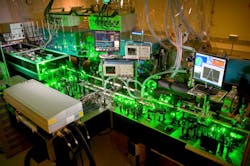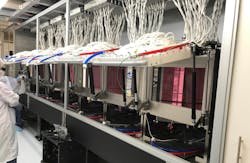Can high-intensity lasers help save the planet?
The race to help save the planet by producing clean energy is on and high-intensity lasers using chirped-pulse amplification are being explored for fusion energy. Why? It’s a promising avenue for clean energy production because it’s safe, environmentally friendly, and efficient.
A startup fusion company, Focused Energy (Austin, TX), is working on an ambitious project to field a credible ignition experiment by the end of 2029—drawing inspiration from Lawrence Livermore National Laboratory’s National Ignition Facility (NIF) in the U.S. and the Extreme Light Infrastructure (ELI) Beamlines project in the Czech Republic.
“2029 is admittedly a very aggressive timescale, but the pressure is coming from the growing realization we need a carbon-free solution that has capacity well beyond standard solar, wind, hydro methods,” says Todd Ditmire, a physics professor at the University of Texas at Austin, as well as the director of the Center for High Energy Density Science, which houses the Texas Petawatt Laser (see Fig. 1).
Ditmire is one of four co-founders of Focused Energy, which also has significant operations in Darmstadt, Germany. Unlike most fusion startups around the world, who are devoted to magnetic confinement fusion, which taps magnetic and electric fields to heat and compress hydrogen plasma, Focused Energy’s approach is direct-drive proton-fast ignition.
Direct-drive proton-fast ignition
Direct-drive proton-fast ignition involves directly imploding fusion fuel with lasers by focusing long-pulse lasers onto the pellet to compresses it, blasting it with a 150 kJ short-pulse laser, and then hitting a nearby target to produce a burst of protons that ignites the pellet.
The indirect-drive inertial confinement fusion approach was pioneered primarily at NIF, which is steadily advancing the field.
In August 2021, after decades of effort and advances, an experiment at NIF reached the threshold of fusion ignition. To do this, researchers focused NIF’s laser light, which is approximately the size of three football fields, onto a target the size of a BB to produce a hotspot the diameter of a human hair. This generated more than 10 quadrillion watts of fusion power for 100 trillionths of a second.
While NIF is pursuing indirect drive inertial confinement fusion, Focused Energy is taking a similar but slightly different path with short-pulse, picosecond high-power, high-intensity lasers as a spark for fusion ignition. “Our grand vision is ultimately to build a facility with up to 150 kJ of picosecond light to start fusion ignition,” says Ditmire.
Accomplishing this goal means building the highest-energy chirped-pulse amplification laser ever built. Design work is already well underway, and the facility will harness 150 kJ, picosecond pulses.
“We’ll also need 400 kJ of long pulses, basically 10 ns pulses, to compress the fuel,” says Ditmire. “We plan to use active cooling so the system can fire once every three minutes.”
By comparison, the laser at NIF fires once every three hours. NIF was designed in the 1990s and uses a flashlamp-pumped laser to produce two megajoules of laser light in the third harmonic (blue light). “Its amplifiers are basically air-cooled,” Ditmire explains.
Focused Energy’s vision is for faster repetition rates so progress can be made more rapidly. “So we’re building the technology to allow us to fire this system once every three minutes, which includes the 150 kJ picosecond beams as well,” he says.
A fusion power plant will ultimately need a laser to fire at 10 Hz, which means it will need a diode-pumped further generation of technology. “We’ve seen huge progress in diode-pumped solid-state lasers within the past decade, so we think it will be a comparable laser technology by the 2030s,” Ditmire adds.
Role of chirped-pulse amplification
Ditmire works with chirped-pulse amplification lasers, a method developed by Gérard Mourou and Donna Strickland in 1985 to generate high-intensity ultrashort optical pulses that eventually earned them the Nobel Prize in Physics in 2018.
Chirped-pulse amplification is special because it creates ultrashort high-intensity laser pulses without destroying the amplifying material. It works by stretching laser pulses in time to reduce their peak power, then they get amplified and compressed. Pulses compressed in time become shorter, so more light can be crammed into a tiny space—which dramatically increases pulse intensity or “sharpness.”
One of the biggest challenges for the fusion mission is it requires a large facility to produce 150 kJ of picosecond pulses, which can’t be accomplished via a single beam. “Our facility will ultimately need around 80 beamlines, each using the standard chirped-pulse amplification technique,” says Ditmire. “The challenge is to bring all of these 80 beamlines down to a half-millimeter spot—onto a fusion target.”
Ditmire helped build the Texas Petawatt Laser, which is a 140 J (pulse energy), 140 fs (pulse width) high-intensity laser that can generate peak power of more than 10 PW. His company, National Energetics, also built the largest chirped-pulse amplification laser (of the four chirped-pulse amplification lasers) for the ELI Beamlines project in Prague, Czech Republic, which produces up to 2 kJ that can be compressed down to 150 fs (see Fig. 2).As a side note, Mourou initiated and led the early development of the ELI project, funded by the European Union and involving three sites in the Czech Republic, Hungary, and Romania to explore extreme light infrastructure. Its site in the Czech Republic focuses on high-energy particle beams.
“ELI’s power amplifier is providing inspiration for the basic building blocks of the big ignition laser we’re going to build,” says Ditmire.
Funding fusion
One of the biggest surprises for Ditmire along this journey so far is the incredible amount of investor interest and support for a big laser endeavor like this, which will cost within the realm of $3 billion.
“There’s a general understanding amongst savvy investors that not only is clean energy our future and the future driver of the economy, but that fusion will likely play a huge role in it,” he says. “We incorporated in July 2021 and raised $15 million in the seed round, which is almost unheard of for deep tech. It’s usually more like $1 million to $2 million, and we’re working to close on $150 million by Q3 2021.”
The lead investor so far is Prime Movers Lab, a deep tech investment firm—and Focused Energy already has three principal investors including U.S. baseball’s Alex Rodriguez, aka A-Rod, and his business partner Marc Lore. “They came in, got briefed on fusion and got excited about it, so they’re part of our seed round investment and we’re in discussions about the next round,” Ditmire says.
Given what they’re seeing within the investment community right now and how hot fusion energy is becoming, “raising money is the least of our concerns,” he says. “Getting this big laser and fusion to work is going to be the challenging part.”
About the Author
Sally Cole Johnson
Editor in Chief
Sally Cole Johnson, Laser Focus World’s editor in chief, is a science and technology journalist who specializes in physics and semiconductors.


